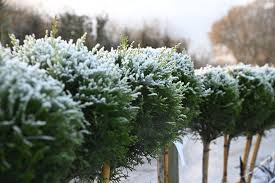End-of-Season Hedge Maintenance: Keeping Privacy Through Winter
End-of-Season Hedge Maintenance
As the growing season winds down across the New Hampshire Seacoast, hedges that provided privacy and structure all summer begin to settle in for winter. In towns like Rye, Portsmouth, and North Hampton, where sea breezes meet early frosts, end-of-season maintenance can make all the difference between a hedge that weathers winter beautifully and one that struggles to recover in spring. At Expert Pruning, we take a thoughtful, seasonal approach—combining fine-gardening precision with a deep understanding of coastal conditions—to help hedges stay healthy, full, and ready for the months ahead.
Why Fall Hedge Maintenance Matters
Autumn is the ideal time to assess your hedges and give them a final tidy-up before winter sets in. By late September through October, growth has slowed, and plants begin redirecting their energy from new shoots to root development. This makes it the perfect window for light shaping and selective pruning. A clean, balanced structure helps hedges stand strong through coastal winds, heavy snow, and fluctuating temperatures that are typical of Zone 6b winters.
Neglecting end-of-season maintenance can lead to uneven growth, weakened branches, and winter breakage—especially for formal hedges like boxwood, privet, or yew. A little attention now ensures privacy and structure remain intact even when leaves have dropped and the landscape turns bare.
Understanding Coastal Conditions
Along the Seacoast, from Exeter to Hampton, conditions can be harsher than inland areas. Wind exposure and salt spray dry out foliage, while freeze–thaw cycles stress roots and stems. Even evergreen hedges like arborvitae or holly can show winter burn if they go into the cold season dry or overgrown.
At Expert Pruning, we often see wind-tunnel effects in properties near the water—particularly in Rye Beach or along Portsmouth’s open lawns. Strategic pruning before winter reduces wind resistance and prevents snow from splitting the upper canopy. Paired with proper mulching and moisture management, these steps create hedges that not only survive but thrive along the coast.
How to Prune Without Stressing the Plant
Fall pruning should focus on light shaping, thinning, and removing dead or damaged growth—never heavy cuts. Removing too much at once encourages late-season growth that won’t harden off before frost, leaving tender shoots vulnerable. Instead, use small, precise cuts to maintain the hedge’s shape and airflow.
For deciduous hedges like beech or hornbeam, prune just enough to keep structure tidy and remove crossing branches. For evergreens like arborvitae, yew, or boxwood, focus on thinning dense areas and trimming long, uneven shoots. Expert Pruning’s team uses hand tools for fine detail work, ensuring natural form and even light distribution throughout the plant.
Maintaining Privacy Year-Round
A well-maintained hedge provides more than beauty—it gives privacy, wind protection, and a sense of enclosure even in winter. When pruned properly, evergreens retain their density and visual barrier without appearing harsh or over-trimmed.
If privacy is a concern during the dormant months, Expert Pruning can help rejuvenate thinning hedges with selective interior pruning that stimulates fuller growth in spring. We also assess soil conditions and recommend mulching or feeding plans to strengthen root systems before the ground freezes. Healthy roots mean stronger, greener foliage when the growing season returns.
The Role of Mulching and Moisture Management
Hedges, especially those near coastal roads or exposed to salt spray, benefit greatly from fall mulching. A two- to three-inch layer of organic mulch helps regulate soil temperature, retain moisture, and protect roots from salt intrusion. Avoid piling mulch directly against stems—it should sit evenly around the base to allow airflow.
Late fall is also the time for one last deep watering, particularly before the ground freezes. Plants that enter winter hydrated are far less likely to experience desiccation or winter burn. At Expert Pruning, we often advise clients in Portsmouth and North Hampton to water hedges thoroughly before Thanksgiving if the autumn has been dry.
Common Coastal Hedge Types and Their Care
Arborvitae (Thuja) – Ideal for privacy screens but prone to snow damage; prune lightly in fall to reduce height strain.
Boxwood – Needs careful thinning to prevent winter dieback; avoid cutting into old wood.
Yew (Taxus) – Extremely tolerant but best shaped late in the season once growth has slowed.
Privet – Great for dense screens; fall trimming helps maintain uniformity through winter.
Holly and Inkberry – Salt-tolerant choices for coastal properties; prune selectively to maintain structure without removing protective foliage.
Each of these species benefits from timing, technique, and precision—the hallmarks of Expert Pruning’s approach.
When to Schedule Professional Hedge Pruning
The best time for professional hedge pruning in Zone 6b is typically from late September through late October. This period allows plants to harden off naturally while still warm enough for minor wound healing. Avoid pruning once night temperatures drop consistently below 40°F, as cuts may not close properly before frost.
Expert Pruning offers tailored maintenance visits for homeowners in Rye, Portsmouth, Exeter, Hampton, and surrounding towns—each visit timed to your plants’ natural cycles. Our fine-gardening team ensures your hedges, shrubs, and ornamental trees stay strong, structured, and ready for winter.
Your Hedge, Ready for Winter
Caring for hedges at the end of the season is about more than appearance—it’s about protecting the investment you’ve made in your landscape. A few hours of professional pruning and maintenance now can prevent costly damage later. With coastal winds, salt spray, and fluctuating winter temperatures, the right preparation makes all the difference.
Whether you need help shaping overgrown evergreens or fine-tuning a formal hedge, Expert Pruning brings the precision and seasonal expertise that Seacoast landscapes demand.
Contact Information:
Expert Pruning — (603) 996-3867 | expertpruning.com
Seacoast Gardener — (603) 770-5072 | seacoastgardener.com


